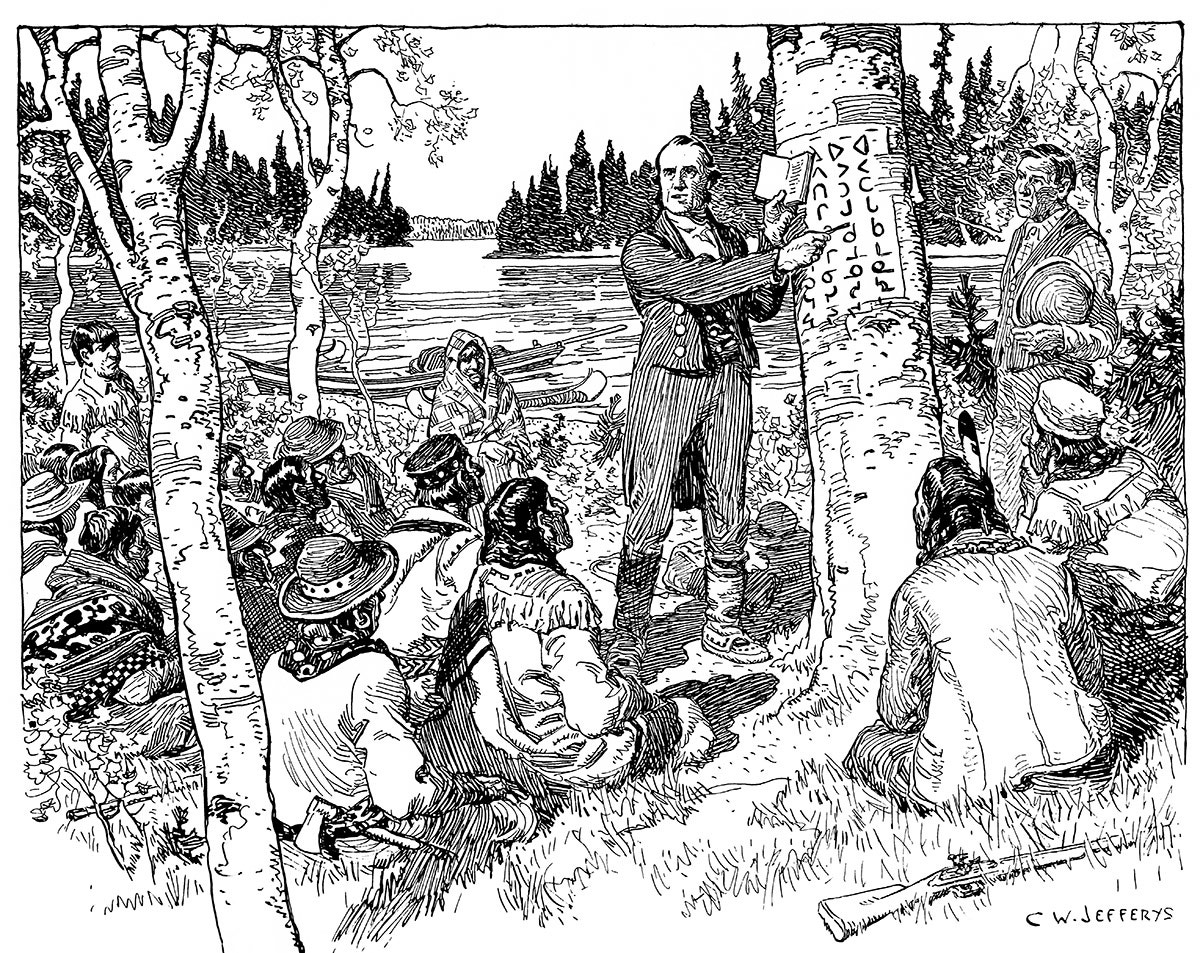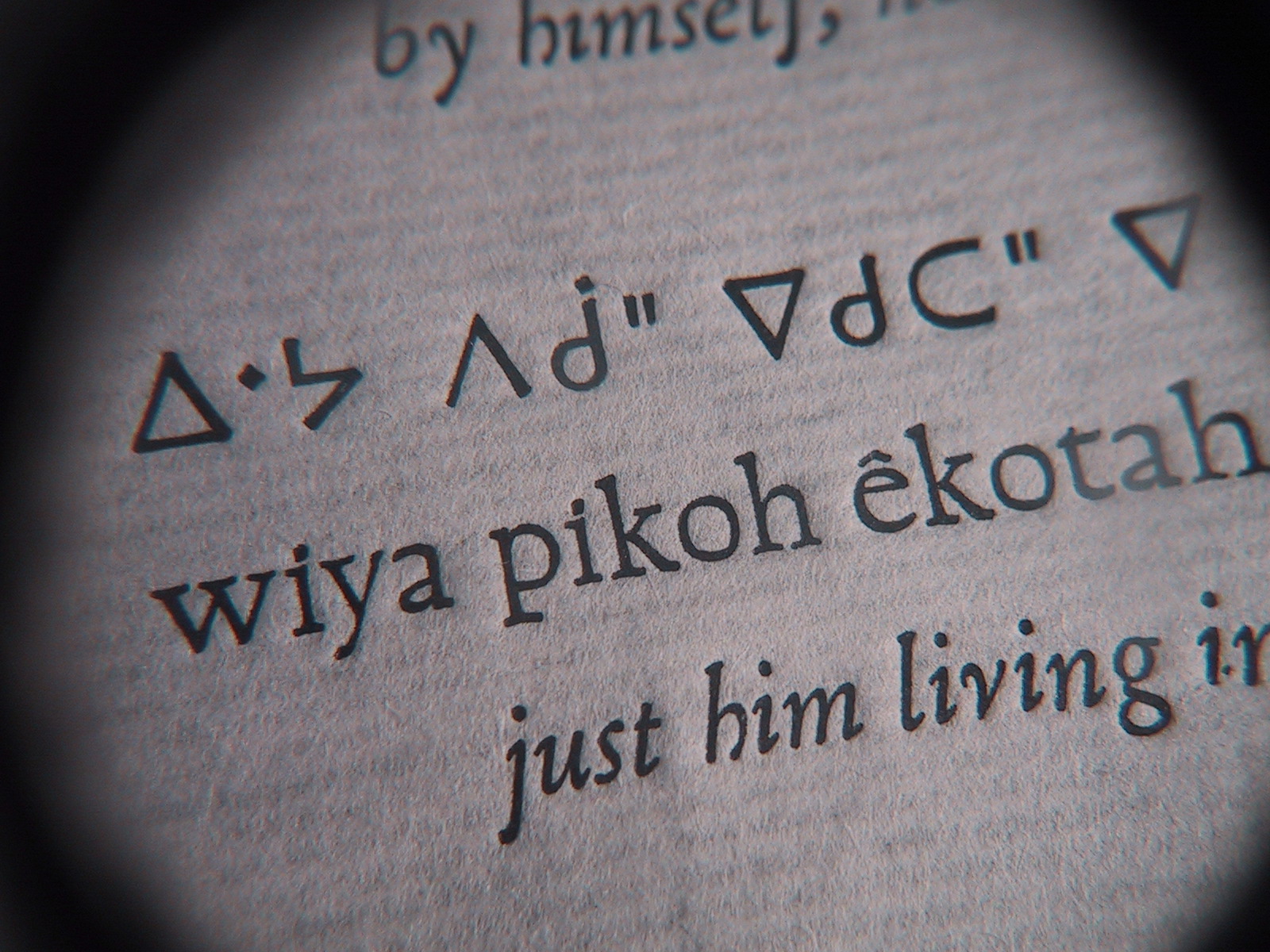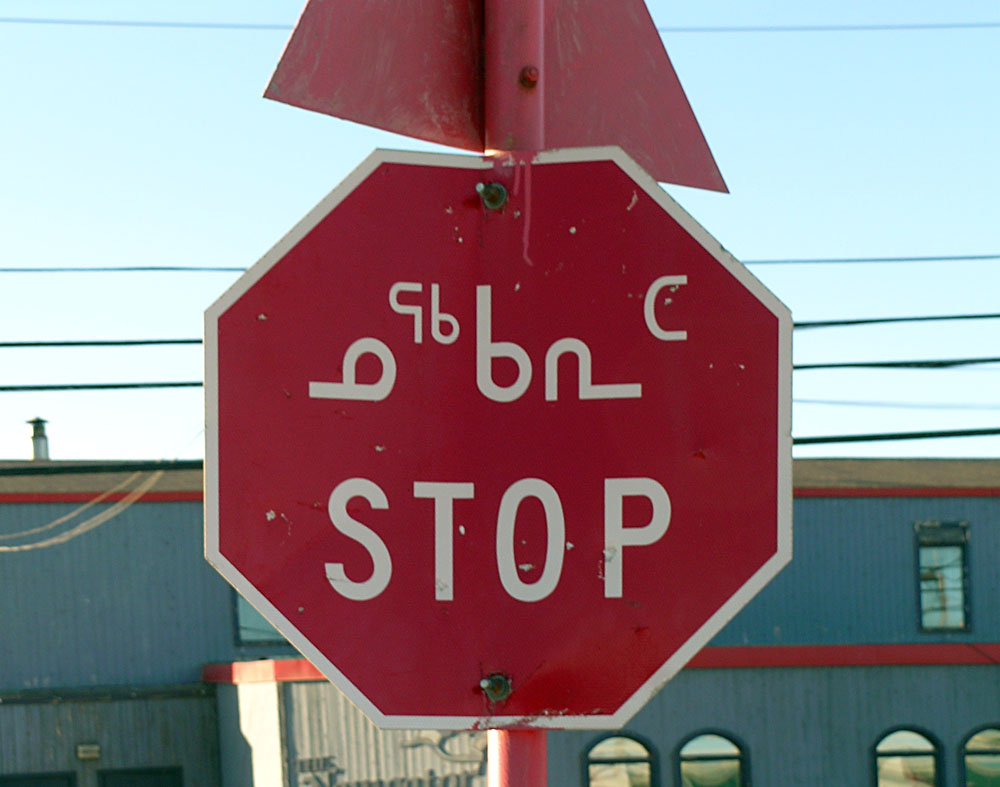|
Canadian Aboriginal Syllabic
Canadian syllabic writing, or simply syllabics, is a family of writing systems used in a number of indigenous Canadian languages of the Algonquian, Inuit, and (formerly) Athabaskan language families. These languages had no formal writing system previously. They are valued for their distinctiveness from the Latin script and for the ease with which literacy can be achieved. For instance, by the late 19th century the Cree had achieved what may have been one of the highest rates of literacy in the world. Syllabics are an abugida, where glyphs represent consonant–vowel pairs, determined by the rotation of the glyphs. They were created by linguist and missionary James Evans working with the Cree and Ojibwe. Canadian syllabics are currently used to write all of the Cree languages from including Eastern Cree, Plains Cree, Swampy Cree, Woods Cree, and Naskapi. They are also used to write Inuktitut in the Canadian Arctic; there they are co-official with the Latin script in the t ... [...More Info...] [...Related Items...] OR: [Wikipedia] [Google] [Baidu] |
Cree Syllabics
Cree syllabics are the versions of Canadian Aboriginal syllabics used to write Cree language, Cree dialects, including the original syllabics system created for Cree and Ojibwe language, Ojibwe. There are two main varieties of syllabics for Cree: Western Cree syllabics and Eastern Cree syllabics. Syllabics were later adapted to several other languages. It is estimated that over 70,000 Algonquian languages, Algonquian-speaking people use the script, from Saskatchewan in the west to Hudson Bay in the east, the US border to District of Mackenzie, Mackenzie and District of Keewatin, Kewatin (the Northwest Territories and Nunavut) in the north. History Cree syllabics were developed for Ojibwe by James Evans (linguist), James Evans, a missionary in what is now Manitoba in the 1830s. Evans had originally adapted the Latin script to Ojibwe (see Ojibwe writing systems#Evans system, Evans system), but after learning of the success of the Cherokee syllabary, he experimented with invented ... [...More Info...] [...Related Items...] OR: [Wikipedia] [Google] [Baidu] |
Abugida
An abugida (; from Geʽez: , )sometimes also called alphasyllabary, neosyllabary, or pseudo-alphabetis a segmental Writing systems#Segmental writing system, writing system in which consonant–vowel sequences are written as units; each unit is based on a consonant letter, and vowel notation is secondary, similar to a diacritical mark. This contrasts with a full alphabet, in which vowels have status equal to consonants, and with an abjad, in which vowel marking is absent, Abjad#Impure abjads, partial, or optional – in less formal contexts, all three types of the script may be termed "alphabets". The terms also contrast them with a syllabary, in which a single symbol denotes the combination of one consonant and one vowel. Related concepts were introduced independently in 1948 by James Germain Février (using the term ) and David Diringer (using the term ''semisyllabary''), then in 1959 by Fred Householder (introducing the term ''pseudo-alphabet''). The Ethiopian Semitic langu ... [...More Info...] [...Related Items...] OR: [Wikipedia] [Google] [Baidu] |
Sayisi Dene
The Sayisi Dene ('People under the Sun' or 'People of the East', ) are Dene Suline peoples, a Dene group, living in northern Manitoba. They are members of the Sayisi Dene First Nation (formerly known as Churchill Indian Band), located at Tadoule Lake (), and are notable for living a nomadic caribou-hunting and gathering existence. They are the most eastern of all the Dene peoples. In 1956, the Sayisi Dene residing at Little Duck Lake () in northern Manitoba were relocated to Churchill. The relocation of the Sayisi Dene is viewed as one of the most grievous errors committed by the federal government.Virginia Phyllis Petch (1998)Relocation and loss of homeland, the story of the Sayisi Dene of Northern Manitoba A Thesis presented to the University of Manitoba in partial fulfillment of the requirements of a Doctor of Philosophy in Anthropology, The University of Manitoba, Winnipeg, Manitoba, June, 1998 Origin The Chipewyan's ancestral homeland stretched west from Hudson Bay, inclu ... [...More Info...] [...Related Items...] OR: [Wikipedia] [Google] [Baidu] |
Latin Script
The Latin script, also known as the Roman script, is a writing system based on the letters of the classical Latin alphabet, derived from a form of the Greek alphabet which was in use in the ancient Greek city of Cumae in Magna Graecia. The Greek alphabet was altered by the Etruscan civilization, Etruscans, and subsequently their alphabet was altered by the Ancient Romans. Several Latin-script alphabets exist, which differ in graphemes, collation and phonetic values from the classical Latin alphabet. The Latin script is the basis of the International Phonetic Alphabet (IPA), and the 26 most widespread letters are the letters contained in the ISO basic Latin alphabet, which are the same letters as the English alphabet. Latin script is the basis for the largest number of alphabets of any writing system and is the List of writing systems by adoption, most widely adopted writing system in the world. Latin script is used as the standard method of writing the languages of Western and ... [...More Info...] [...Related Items...] OR: [Wikipedia] [Google] [Baidu] |
Indigenous Canadian Languages
A multitude of languages have always been spoken in Canada. Prior to Confederation, the territories that would become Canada were home to over 70 distinct languages across 12 or so language families. Today, a majority of those indigenous languages are still spoken; however, most are endangered and only about 0.6% of the Canadian population report an indigenous language as their mother tongue. Since the establishment of the Canadian state, English and French have been the co-official languages and are, by far, the most-spoken languages in the country. According to the 2021 census, English and French are the mother tongues of 56.6% and 20.2% of Canadians respectively. In total, 86.2% of Canadians have a working knowledge of English, while 29.8% have a working knowledge of French. Under the ''Official Languages Act'' of 1969, both English and French have official status throughout Canada in respect of federal government services and most courts. All federal legislation is enacted ... [...More Info...] [...Related Items...] OR: [Wikipedia] [Google] [Baidu] |
Ojibwe Syllabics
Ojibwe The Ojibwe (; Ojibwe writing systems#Ojibwe syllabics, syll.: ᐅᒋᐺ; plural: ''Ojibweg'' ᐅᒋᐺᒃ) are an Anishinaabe people whose homeland (''Ojibwewaki'' ᐅᒋᐺᐘᑭ) covers much of the Great Lakes region and the Great Plains, n ... is an Indigenous languages of the Americas, indigenous language of North America from the Algonquian languages, Algonquian language family. Ojibwe is one of the largest Native American languages north of Mexico in terms of number of speakers and is characterized by a series of dialects, some of which differ significantly. The dialects of Ojibwe are spoken in Canada from southwestern Quebec, through Ontario, Manitoba and parts of Saskatchewan, with outlying communities in Alberta and British Columbia,Nichols, John, 1980, pp. 1-2 and in the United States from Michigan through Wisconsin and Minnesota, with a number of communities in North Dakota and Montana, as well as migrant groups in Kansas and Oklahoma. The absence of li ... [...More Info...] [...Related Items...] OR: [Wikipedia] [Google] [Baidu] |
Carrier Syllabics
Carrier or Déné syllabics (, Dʌlk'ʷahke, (Dulkw'ahke) meaning ''frog feet'') is a writing system created by Adrien-Gabriel Morice for the Carrier language. It was inspired by Cree syllabics and is one of the writing systems in the Canadian Aboriginal syllabics Unicode range. History The Dakelh people once enjoyed extensive literacy with the script. It is recorded that it was often used to write messages on trees, and Morice published a newspaper in syllabics which was in print from 1891 to 1894. Some transcriptions of Latin and English have been recorded as well. Its usage began to decline around 1920, when the Carrier language was banned from the local schools. In liturgical publications, such as prayer books, the Carrier language became written in a non-standard form of the Latin alphabet, which used many English sound values, such as for and for . In the 1960s, the Carrier Linguistic Committee (CLC) in Fort St. James created a standardized form of the Latin alphabet ... [...More Info...] [...Related Items...] OR: [Wikipedia] [Google] [Baidu] |
Ojibwe Writing Systems
Ojibwe language, Ojibwe is an Indigenous languages of the Americas, indigenous language of North America from the Algonquian languages, Algonquian language family. Ojibwe is one of the largest Native American languages north of Mexico in terms of number of speakers and is characterized by a series of dialects, some of which differ significantly. The dialects of Ojibwe are spoken in Canada from southwestern Quebec, through Ontario, Manitoba and parts of Saskatchewan, with outlying communities in Alberta and British Columbia,Nichols, John, 1980, pp. 1-2 and in the United States from Michigan through Wisconsin and Minnesota, with a number of communities in North Dakota and Montana, as well as migrant groups in Kansas and Oklahoma. The absence of linguistic or political unity among Ojibwe, Ojibwe-speaking groups is associated with the relative autonomy of the regional dialects of Ojibwe. There is no single dialect that is considered the most prestigious or most prominent, and no st ... [...More Info...] [...Related Items...] OR: [Wikipedia] [Google] [Baidu] |
Eastern Cree Syllabics
Eastern Cree syllabics are a variant of Canadian Aboriginal syllabics used to write all the Cree language, Cree dialects from Moosonee, Ontario to Kawawachikamach, Quebec, Kawawachikamach on the Quebec–Labrador border in Canada that use syllabics. Cree syllabics uses different glyphs to indicate consonants, and changes the orientation of these glyphs to indicate the vowel that follows it. The basic principles of Canadian syllabic writing are outlined in the article for Canadian Aboriginal syllabics. In this article, Cree words and sounds will transcribed using the ''Standard Roman Orthography''. Inventory The primary difference between eastern and western Cree orthographies is the shape of the final consonants (consonant sounds with no following vowel). Eastern Cree dialects write finals with a superscripted a-syllabic. ᒫᔅᑰᒡ /māskōc/ has two finals, ᔅ /s/ and ᒡ /c/. Other differences are placing the diacritic for labialization (/w/) before rather than after the l ... [...More Info...] [...Related Items...] OR: [Wikipedia] [Google] [Baidu] |
Western Cree Syllabics
Western Cree syllabics are a variant of Canadian Aboriginal syllabics used to write Plains Cree, Woods Cree and the western dialects of Swampy Cree. It is used for all Cree dialects west of approximately the Manitoba–Ontario border in Canada, as opposed to Eastern Cree syllabics. It is also occasionally used by a few Cree speakers in the United States. Phonology of languages using Western Cree syllabics Western syllabics use only those characters needed to write the phonemes of the western dialects. The table below demonstrates the phonemes present in Western Cree dialects. Each sound is presented with a transcription in the International Phonetic Alphabet along with the characters used to represent the sound in the ''Standard Roman Orthography'' used to teach Plains Cree. Plosives are never aspirated. For example in Western Cree is always contrasting with English where can be or depending on the surrounding context. The phoneme is only present in Woods Cree. ... [...More Info...] [...Related Items...] OR: [Wikipedia] [Google] [Baidu] |
Inuktitut Syllabics
Inuktitut syllabics (, or , ) is an abugida-type writing system used in Canada by the Inuktitut-speaking Inuit of the Provinces and territories of Canada, territory of Nunavut and the Nunavik region of Quebec. In 1976, the Language Commission of the Inuit Cultural Institute made it the co-official script for the Inuit languages, along with the Latin script. The name derives from the root , meaning "mouth". The alternative, Latin-based writing system is named Inuit languages#Writing, (), and it derives from , a word describing the markings or the grain in rocks. meaning "new writing system" is to be seen in contrast to (), the "old syllabics" used before the reforms of 1976. Inuktitut is one variation on Canadian Aboriginal syllabics, and can be digitally encoded using the Unicode standard. The Unicode block for Inuktitut characters is called Unified Canadian Aboriginal Syllabics (Unicode block), Unified Canadian Aboriginal Syllabics. History The first efforts to write In ... [...More Info...] [...Related Items...] OR: [Wikipedia] [Google] [Baidu] |
Pitman Shorthand
Pitman shorthand is a system of shorthand for the English language developed by Englishman Sir Isaac Pitman (1813–1897), who first presented it in 1837. Like most systems of shorthand, it is a phonetic system; the symbols do not represent letters, but rather sounds, and words are, for the most part, written as they are spoken. Shorthand was referred to as phonography in the 19th century. It was first used by newspapers who sent phonographers to cover important speeches, usually stating (as a claim of accuracy) that they had done so. The practice got national attention in the United States in 1858 during the Lincoln–Douglas Debates which were recorded phonographically. The shorthand was converted into words during the trip back to Chicago, where typesetters and telegraphers awaited them. Pitman shorthand was the most popular shorthand system used in the United Kingdom and the second most popular in the United States. One characteristic feature of Pitman shorthand is that un ... [...More Info...] [...Related Items...] OR: [Wikipedia] [Google] [Baidu] |


